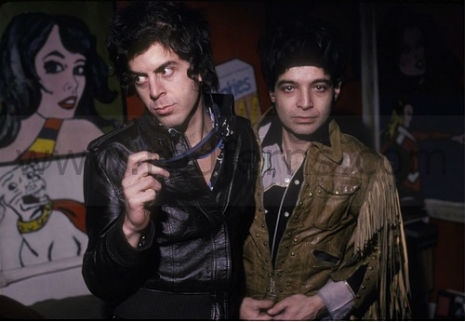
I was late to the party, but I think many of us were late to that party. Suicide had been playing for about a decade before we started really noticing what was going on—and what we were missing.
When Suicide played in England during the 1970s they were pelted with bottles. The punk audience was horrified by this intense, strange band. This wasn’t punk. This wasn’t New Wave. It wasn’t. This was a glimpse of the future.
I never heard Suicide on the radio. Not once. Or in the record shops that blasted out The Clash, the Banshees or PiL. Or even in the clubs. When I first heard “Ghost Rider”—a long long time after its release—it was a visceral thrill. Mesmeric, powerful, unforgettable.
In fact Alan Vega best described the effect of hearing Suicide from his own experience of hearing Martin Rev. In an interview Vega said that he had never wanted to be on stage. He was a sculptor, an artist, not a performer. He liked playing around with tape machines and noise, sure. He liked listening to the Velvet Underground and the Stooges, of course. But the thought of being a musical artist—the thought of performing on stage, I mean—scared him shitless.
Then one night Vega was standing at the side of a stage watching Martin Rev playing jazz funk fusion. Something happened. The sounds cut through him. He was no longer just a spectator. He was possessed. Vega started hitting a tambourine. With every beat he was getting ever nearer ever closer to being onstage. He was no longer scared. He felt alive. That’s almost how it felt the first time I heard “Ghost Rider.” It’s a powerful song.
But back to that night when Vega started slamming a tambourine: Martin Rev turned to him and said “We’re going to do something together.” They would commit Suicide.

The group started out in 1970 as three piece band. The guitarist “who was like a free-sound guitarist and also a visual artist” soon left to make films. As Vega and Rev told Igloo Mag in 2008:
Martin Rev: We knew we weren’t going to keep a band together for that long based on what we did, the amount of space we might have for rehearsal, which was always limited, and the amount of money we had for equipment and the amount we gigs we had. We were starting from scratch.
Alan Vega: We started out with a ten dollar Japanese keyboard that Marty found somewhere. We could hardly get any sound out of it so we started introducing, was it an Electro Harmonix thing like bass boosters and treble boosters?
Martin Rev: Yeah.
Alan Vega: This keyboard would be lined up with five or six of these things and that would jack up the sound because we almost couldn’t get any sound out of this thing. That in a way created the sound. As Marty was saying, it was out of a necessity thing. We had to jack up that keyboard, man, and out came this incredible rush of sound that no one has ever heard before or afterwards. The sound was created just out of necessity and we ran with it, man. It’s also more than that. I mean, Marty and I, we were both hearing electronics. In the late 60s I was already fooling around with just noise, just radio static and shit. It’s our musical taste. We like to hear noise, you know?
They spent years of gigging. Working on their own distinct sound. A psychotic, yelping Gene Vincent vocal over a mix of repetitive pounding synthesiser beats, white noise and menacing throbbing, pulsating psychobilly.
In 1977, Suicide released their eponymous debut album. It took seven years of trial and error to create the songs, then just four short days to record. As Martin Rev told the Guardian last year “We started like sculptors”:
“With a big piece of stone, pure clay, pure sound, big lumps of sound. We started from scratch, and then out of that we carved out the songs. After a year or two, we were playing the earliest, “Ghost Rider,” “Cheree” and “Rocket USA.” Also, when I was finally able to get a rhythm machine, that changed things a lot. I was able to delineate songs more clearly. The first year or two was a pure wall of sound.”
Hard to believe now, but this stunning debut record failed to chart in either the US or the UK. Both countries were too hung up on punk and disco and new wave. Some critics loved the album (as did Bruce Springsteen who made a hit of “Dream Baby Dream” and film-maker Rainer Werner Fassbinder), but others were literally terrified by their sound.
In the end Vega and Rev won.
Since those heady days Vega has most recently come through a heart attack and a stroke. He still performs with Rev and still produces artwork—last year he exhibited a series of new and old paintings at the Armory Show in New York.
Rev is “always looking for the next cool instrument or pedal. I’m not using software, live, so not everything works for me; I don’t need everything.”
“You bring your life with you….The way you are in the present, what you’ve learned, what you know.”
“Diamonds, Fur Coat, Champagne” shot at Hurrah’s in 1980 by Charles Libin & Paul Cameron, ASC
“Frankie Teardrop” video directed by Paul Dougherty.
Suicide live at CBGB’s in 1986. Shot by Greg Fasolino.
‘Radiation’ video
A live “Ghost Rider” from a Japanese doc called ‘Underground USA’
“Sweetheart” and “Touch Me” at Hurrah’s in 1980, videotaped by Charles Libin & Paul Cameron, ASC
Suicide’s Alan Vega and Martin Rev interviewed at an All Tomorrow’s Parties event in upstate New York in 2012 for Noisey’s ‘Soft Focus’ series
Suicide segment of ‘Punk Attitude.’
Previously on Dangerous Minds